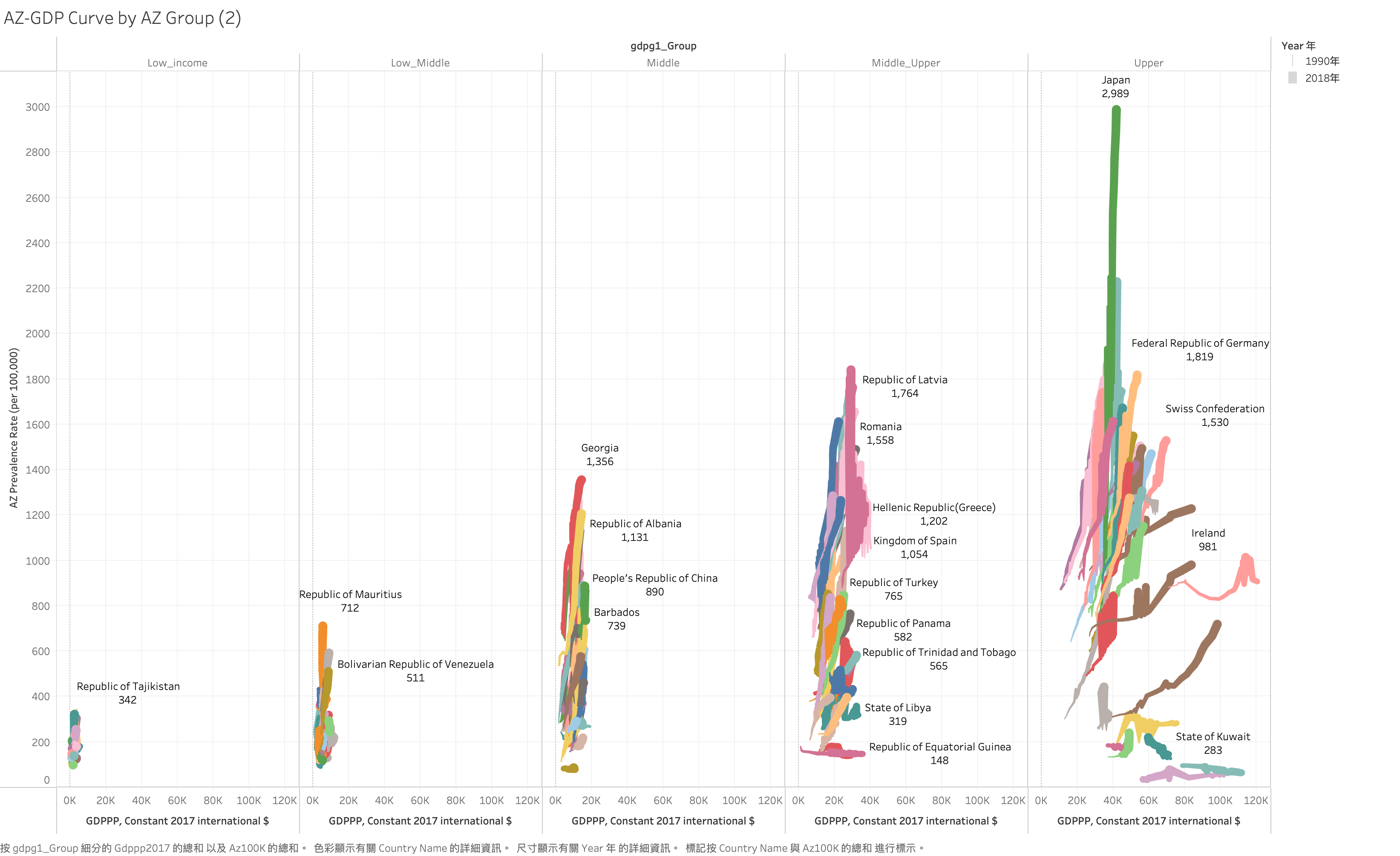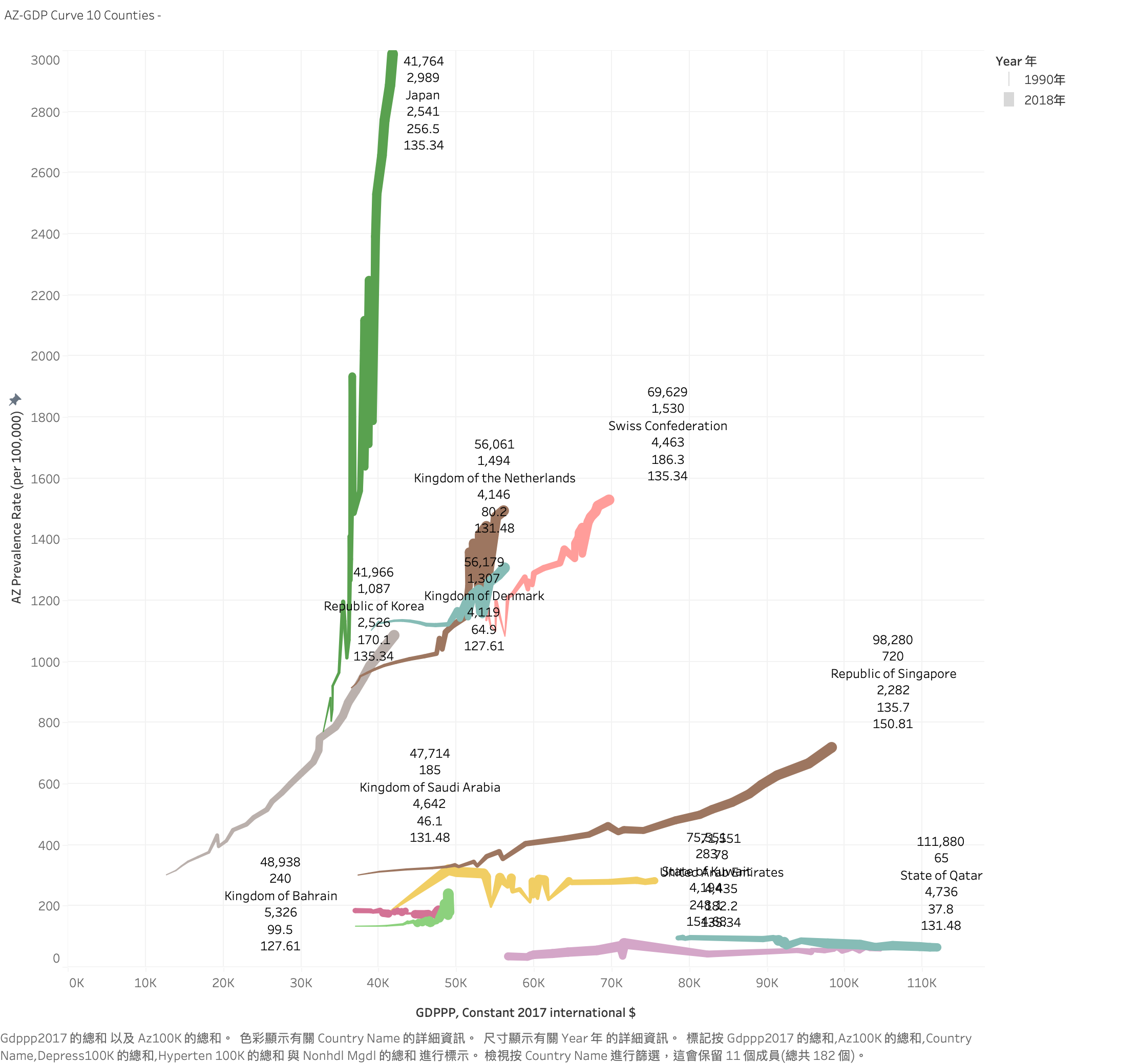Machine Learning | Study | K-Means 分群 | GDP Clustering

C.Y.LU 2024-05-20
基本概念
K-Means 的目標是將數據點分成 K 個群集,使得每個群集中的數據點彼此之間的距離最小,而與其他群集的數據點距離最大。該演算法依賴於以下幾個步驟:
- 選擇 K 個初始中心點(Centroids):這些中心點可以隨機選擇,也可以使用其他方法確定。
- 分配數據點:將每個數據點分配給最近的中心點,形成 K 個群集。
- 更新中心點:重新計算每個群集的中心點,通常是該群集所有數據點的平均值。
- 重複步驟 2 和 3:直到中心點不再變化或達到預定的迭代次數。
演算法步驟
具體步驟如下:
- 初始化 K 個中心點。
- 將每個數據點分配給距離最近的中心點,形成 K 個群集。
- 計算每個群集的新中心點。
- 檢查中心點是否發生變化,如果變化,則返回步驟 2,否則結束。
數學背景
K-Means 的目標是最小化群內平方和(Within-Cluster Sum of Squares, WCSS)
優點與缺點
優點:
- 簡單易懂,實現簡單。
- 計算速度快,適合大數據集。
缺點:
- 需要事先指定 K 值。
- 對初始值敏感,不同的初始中心點可能導致不同的結果。
- 只能發現凸形狀的群集,對於非凸形狀或尺寸差異較大的群集效果不佳 (Machine Learning Plus) (Learn R, Python & Data Science Online) (Analytics Vidhya)。
使用情境
K-Means 常用於以下應用:
- 客戶分群:根據客戶行為數據將客戶分成不同的群集,以進行市場營銷。
- 圖像分割:將圖像中的像素分成不同的區域,以進行圖像處理。
- 文件聚類:將相似的文件分成相同的群集,以進行文本處理和信息檢索 (Analytics Vidhya) (Pythonic Perambulations)。
實際示例
假設我們有一個數據集,包含各國的GDPPP及疾病盛行率。我們希望將這些客戶分成五個群集,步驟如下:
- 隨機選擇五個初始中心點。
- 計算每個客戶到這五個中心點的距離,將每個客戶分配給最近的中心點。
- 重新計算每個群集的中心點。
- 重複分配和更新,直到中心點不再變化。
這樣我們就可以將客戶分成五個群集,每個群集代表一組具有相似消費行為的客戶。
K-Means 是一個強大且常用的工具,但在實際應用中需要考慮其局限性和參數選擇。
實作
import numpy as np
# Import necessary libraries
from google.colab import drive
import pandas as pd
from sklearn.cluster import KMeans
from sklearn.preprocessing import StandardScaler
from sklearn.impute import SimpleImputer
# Mount Google Drive
drive.mount('/content/drive')
# Read the CSV file into a pandas DataFrame
df = pd.read_csv('/content/drive/MyDrive/KMEAN/AZRV_20182_0523.csv')
# Convert the 'gdppp' column to float
df['gdppp2017'] = df['gdppp2017'].astype(float)
# Group the data by GDPPP into five groups
df['GDP_Group2017'] = pd.qcut(df['gdppp2017'], q=5, labels=False)
# Select the features
# features = ['az100k', 'pop_65y_pct', 'primaryedu_year', 'hyperten_100k','depress100K', 'nonhdl_mgdl']
features = ['az100k', 'pop_65y_pct', 'primaryedu_year', 'hyperten_100k','depress100k', 'nonhdl_mgdl']
# Only keep the GDP_Group and other features
X = df[features]
# Standardize the features
scaler = StandardScaler()
X_scaled = scaler.fit_transform(X)
# Impute missing values with the mean
imputer = SimpleImputer(strategy='mean')
X_scaled = imputer.fit_transform(X_scaled)
# Check for missing values
missing_values = np.isnan(X_scaled).sum()
print(missing_values)
# Use K-means clustering to cluster the data into five groups
kmeans = KMeans(n_clusters=5, random_state=42)
kmeans.fit(X_scaled)
labels = kmeans.labels_
# Add the cluster labels to the original data
df['Group'] = labels
# Print the summary statistics for each cluster
group_stats = df.groupby('Group')[features].describe()
print(group_stats)
# If you need to save the clustered data
df.to_csv('20182-3_grouped.csv', index=False)
Output, 分群
import numpy as np
# Import necessary libraries
from google.colab import drive
import pandas as pd
from sklearn.cluster import KMeans
from sklearn.preprocessing import StandardScaler
from sklearn.impute import SimpleImputer
# Mount Google Drive
…group_stats = df.groupby('Group')[features].describe()
print(group_stats)
# If you need to save the clustered data
df.to_csv('20182-3_grouped.csv', index=False)
Drive already mounted at /content/drive; to attempt to forcibly remount, call drive.mount("/content/drive", force_remount=True).
0
/usr/local/lib/python3.10/dist-packages/sklearn/cluster/_kmeans.py:870: FutureWarning: The default value of `n_init` will change from 10 to 'auto' in 1.4. Set the value of `n_init` explicitly to suppress the warning
warnings.warn(
az100k \
count mean std min 25% 50%
Group
0 42.0 570.731959 279.813076 77.854194 413.589506 514.001773
1 29.0 1357.713112 359.876139 642.569608 1229.188301 1423.406956
2 39.0 333.656546 186.450738 87.086735 214.407278 298.565050
3 20.0 1471.588495 504.890367 765.350228 1188.206307 1395.787605
4 52.0 183.498420 78.811741 87.810353 135.230484 156.533061
pop_65y_pct ... depress100k \
75% max count mean ... 75%
Group ...
0 709.346476 1316.266357 42.0 7.546905 ... 4122.836259
1 1624.709701 1912.203997 29.0 15.430000 ... 4830.947694
2 386.726109 1082.130196 39.0 5.138462 ... 3024.226697
3 1661.257484 2989.455411 20.0 17.926000 ... 4384.161605
4 197.502121 477.291516 52.0 3.234615 ... 4315.502244
nonhdl_mgdl \
max count mean std min 25%
Group
0 5332.211057 42.0 132.766177 8.353623 116.009281 127.610209
1 6033.519387 29.0 135.344161 8.396135 119.876257 127.610209
2 3749.435931 39.0 134.550935 10.503569 116.009281 127.610209
3 5011.843218 20.0 139.984532 6.940174 127.610209 135.344161
4 5325.835877 52.0 109.688262 7.425607 92.807425 108.275329
50% 75% max
Group
0 131.477185 139.211137 158.546017
1 131.477185 139.211137 150.812065
2 135.344161 143.078113 162.412993
3 143.078113 143.078113 150.812065
4 108.275329 112.142305 131.477185
[5 rows x 48 columns

Visualization
WDI 的 GDPPP Grouping : US$ 996, 3895,12055 , 4 Group
K-Mean clustering : GDPPP: (3513),(9,636),(16145),( 34,040 ) 5 Group


